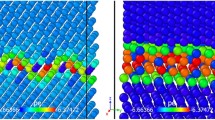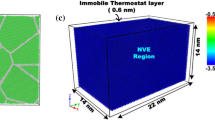Abstract
Grain boundaries (GBs) can serve as effective sinks for radiation-induced defects, thus notably influencing the service performance of materials. However, the effect of GB structures on the zero-dimensional defects induced by irradiation has not been fully elucidated. Here, the evolution of cascade collision in the single-crystal (SC), bicrystalline (BC), and twinned crystalline (TC) copper is studied by atomic simulations during irradiation. The spatial distributions of vacancies and interstitials are closely related to the GB at a certain primary knock-on atom (PKA) energy. Compared with the TC, the BC displays a more obvious segregation of the interstitial atoms near GB, due to the characteristic of the greater interstitial binding energy. The evolution of Frenkel pairs is more sensitive to the change of the GB position in the BC. A more prominent defect annihilation rate is caused by the effect of the GB than that of the twin boundary (TB). The marked secondary emission phenomenon has been observed in the BC, which promotes the formation of an inverted pagoda-like defect distribution. There are similar sub-conical defect distributions and microstructures induced by cascade collision in the TC and the SC. It has been found that the influence range of the GB is wider in the BC. Meanwhile, the average flow stress of the irradiated copper is quantitatively calculated by establishing a physical strengthening model. The contribution of vacancy to the average flow stress in the irradiated BC and TC is obvious than that in the SC, due to the formation of many vacancies. This study provides a theoretical basis for further understanding and customization of the metal-based equipment with good radiation resistance.
Similar content being viewed by others
References
BRINKMAN, J. A. On the nature of radiation damage in metals. Journal of Applied Physics, 25(8), 961–970 (1954)
JIN, M., CAO, P., YIP, S., and SHORT, M. P. Radiation damage reduction by grain-boundary biased defect migration in nanocrystalline Cu. Acta Materialia, 155, 410–417 (2018)
VETTERICK, G. A., GRUBER, J., SURI, P. K., BALDWIN, J. K., KIRK, M. A., BALDO, P., WANG, Y. Q., MISRA, A., TUCKER, J., and TAHERI, M. L. Achieving radiation tolerance through non-equilibrium grain boundary structures. Scientific Reports, 7(1), 1–9 (2017)
HAN, W. Z., DEMKOWICZ, M. J., FU, E. G., WANG, Y. Q., and MISRA, A. Effect of grain boundary character on sink efficiency. Acta Materialia, 60(18), 6341–6351 (2012)
BARR, C. M., NATHANIEL, J. E., II, UNOCIC, K. A., LIU, J., ZHANG, Y., WANG, Y., and TAHERI, M. L. Exploring radiation induced segregation mechanisms at grain boundaries in equiatomic CoCrFeNiMn high entropy alloy under heavy ion irradiation. Scripta Materialia, 156, 80–84 (2018)
CHEN, Y., LIU, Y., FANG, Q., LI, J., LIU, Y., and LIAW, P. K. An unified model for dislocations interacting with complex-shape voids in irradiated metals. International Journal of Mechanical Sciences, 185, 105689 (2020)
BAI, X. M., VOTER, A. F., HOAGLAND, R. G., NASTASI, M., and UBERUAGA, B. P. Efficient annealing of radiation damage near grain boundaries via interstitial emission. Science, 327(5973), 1631–1634 (2010)
CHEN, D., WANG, J., CHEN, T., and SHAO, L. Defect annihilation at grain boundaries in alpha-Fe. Scientific Reports, 3(1), 1–5 (2013)
SUN, C., SONG, M., YU, K. Y., CHEN, Y., KIRK, M., LI, M., WANG, H., and ZHANG, X. In situ evidence of defect cluster absorption by grain boundaries in Kr ion irradiated nanocrystalline Ni. Metallurgical and Materials Transactions A, 44(4), 1966–1974 (2013)
SONG, M., WU, Y. D., CHEN, D., WANG, X. M., SUN, C., YU, K. Y., CHEN, Y., SHAO, L., YANG, Y., HARTWIG, K. T., and ZHANG, X. Response of equal channel angular extrusion processed ultrafine-grained T91 steel subjected to high temperature heavy ion irradiation. Acta Materialia, 74, 285–295 (2014)
SHEN, T. D., FENG, S., TANG, M., VALDEZ, J. A., WANG, Y., and SICKAFUS, K. E. Enhanced radiation tolerance in nanocrystalline MgGa2O4. Applied Physics Letters, 90(26), 263115 (2007)
LI, J., YU, K. Y., CHEN, Y., SONG, M., WANG, H., KIRK, M. A., LI, M., and ZHANG, X. In situ study of defect migration kinetics and self-healing of twin boundaries in heavy ion irradiated nanotwinned metals. Nano Letters, 15(5), 2922–2927 (2015)
SCHNEIDER, M., GEORGE, E. P., MANESCAU, T. J., ZÁLEŽÁK, T., HUNFELD, J., DLOUHÝ, A., EGGELER, G., and LAPLANCHE, G. Analysis of strengthening due to grain boundaries and annealing twin boundaries in the CrCoNi medium-entropy alloy. International Journal of Plasticity, 124, 155–169 (2020)
ZHENG, Y., LI, Q., ZHANG, J., YE, H., ZHANG, H., and SHEN, L. Hetero interface and twin boundary mediated strengthening in nano-twinned Cu/Ag multilayered materials. Nanotechnology, 28(41), 415705 (2017)
GUO, X., CHEN, C., KANG, R., and JIN, Z. Study of mechanical properties and subsurface damage of quartz glass at high temperature based on MD simulation. Journal of Micromechanics and Molecular Physics, 4(2), 1950003 (2019)
FANG, Q., CHEN, Y., LI, J., JIANG, C., LIU, B., LIU, Y., and LIAW, P. K. Probing the phase transformation and dislocation evolution in dual-phase high-entropy alloys. International Journal of Plasticity, 114, 161–173 (2019)
LIN, Y., YANG, T., LANG, L., SHAN, C., DENG, H., HU, W., and GAO, F. Enhanced radiation tolerance of the Ni-Co-Cr-Fe high-entropy alloy as revealed from primary damage. Acta Materialia, 196, 133–143 (2020)
DENG, Q. Q., GAO, Y. J., LIU, Z. Y., HUANG, Z. J., LI, Y. X., and LUO, Z. R. Atomistic simulation of void growth by emitting dislocation pair during deformation. Physica B: Condensed Matter, 578, 411767 (2020)
LI, J., FANG, Q., LIU, B., and LIU, Y. Transformation induced softening and plasticity in high entropy alloys. Acta Materialia, 147, 35–41 (2018)
TERAYAMA, S., IWASE, Y., HAYAKAWA, S., OKITA, T., ITAKURA, M., and SUZUKI, K. Molecular dynamic simulations evaluating the effect of the stacking fault energy on defect formations in face-centered cubic metals subjected to high-energy particle irradiation. Computational Materials Science, 195, 110479 (2021)
LI, L., CHEN, H., FANG, Q., LI, J., LIU, F., LIU, Y., and LIAW, P. K. Effects of temperature and strain rate on plastic deformation mechanisms of nanocrystalline high-entropy alloys. Intermetallics, 120, 106741 (2020)
LI, J., FANG, Q., LIU, Y., and ZHANG, L. A molecular dynamics investigation into the mechanisms of subsurface damage and material removal of monocrystalline copper subjected to nanoscale high speed grinding. Applied Surface Science, 303, 331–343 (2014)
GAO, Y., YANG, T., XUE, J., YAN, S., ZHOU, S., WANG, Y., KWOK, T. K., CHU, P. K., and ZHANG, Y. Radiation tolerance of Cu/W multilayered nanocomposites. Journal of Nuclear Materials, 413(1), 11–15 (2011)
ZHANG, L., LU, C., and TIEU, A. K. Nonlinear elastic response of single crystal Cu under uniaxial loading by molecular dynamics study. Materials Letters, 227, 236–239 (2018)
LUO, G., LI, L., FANG, Q., LI, J., TIAN, Y., LIU, Y., LIU, B., PENG, J., and LIAW, P. K. Microstructural evolution and mechanical properties of FeCoCrNiCu high entropy alloys: a microstructure-based constitutive model and a molecular dynamics simulation study. Applied Mathematics and Mechanics (English Edition), 42(8), 1109–1122 (2021) https://doi.org/10.1007/s10483-021-2756-9
JIN, M., CAO, P., and SHORT, M. P. Mechanisms of grain boundary migration and growth in nanocrystalline metals under irradiation. Scripta Materialia, 163, 66–70 (2019)
LI, B., LI, H. Y., and LUO, S. N. Molecular dynamics simulations of displacement cascades in nanotwinned Cu. Computational Materials Science, 152, 38–42 (2018)
DO, H. S. and LEE, B. J. Origin of radiation resistance in multi-principal element alloys. Scientific Reports, 8(1), 1–9 (2018)
STUKOWSKI, A. Visualization and analysis of atomistic simulation data with OVITO — the open visualization tool. Modelling and Simulation in Materials Science and Engineering, 18(1), 015012 (2009)
BAI, X. M., VERNON, L. J., HOAGLAND, R. G., VOTER, A. F., NASTASI, M., and UBERUAGA, B. P. Role of atomic structure on grain boundary-defect interactions in Cu. Physical Review B, 85(21), 214103 (2012)
DENG, H. F. and BACON, D. J. Simulation of point defects and threshold displacements in pure Cu and a dilute Cu-Au alloy. Physical Review B, 48(14), 10022 (1993)
ANDERSON, P. M., HIRTH, J. P., and LOTHE, J. Theory of Dislocations, Cambridge University Press, Cambridge (2017)
MARTORANO, M. A., SANDIM, H. R. Z., FORTES, M. A., and PADILHA, A. F. Observations of grain boundary protrusions in static recrystallization of high-purity bcc metals. Scripta Materialia, 56(10), 903–906 (2007)
ZHOU, H., LI, X., QU, S., YANG, W., and GAO, H. A jogged dislocation governed strengthening mechanism in nanotwinned metals. Nano Letters, 14(9), 5075–5080 (2014)
ZHAO, Y., ZHANG, J., WANG, Y., WU, S., LIANG, X., WU, K., LIU, G., and SUN, J. The metastable constituent effects on size-dependent deformation behavior of nanolaminated micropillars: Cu/FeCoCrNi vs Cu/CuZr. Journal of Materials Science Technology, 68, 16–29 (2021)
XIAO, X., TERENTYEV, D., YU, L., BAKAEV, A., JIN, Z., and DUAN, H. Investigation of the thermo-mechanical behavior of neutron-irradiated Fe-Cr alloys by self-consistent plasticity theory. Journal of Nuclear Materials, 477, 123–133 (2016)
PENG, J., LI, L., LI, F., LIU, B., ZHEREBTSOV, S., FANG, Q., LI, J., STEPANOV, N., LIU, Y., LIU, F., and LIAW, P. K. The predicted rate-dependent deformation behaviour and multistage strain hardening in a model heterostructured body-centered cubic high entropy alloy. International Journal of Plasticity, 145, 103073 (2021)
LI, J., WENG, G. J., CHEN, S., and WU, X. On strain hardening mechanism in gradient nanostructures. International Journal of Plasticity, 88, 89–107 (2017)
Author information
Authors and Affiliations
Corresponding author
Additional information
Project supported by the National Natural Science Foundation of China (Nos. 51871092 and 11772122) and the Foundation for Innovative Research Groups of the National Natural Science Foundation of China (No. 51621004)
Rights and permissions
About this article
Cite this article
Peng, J., Cui, S., Tian, Y. et al. Effects of grain boundary on irradiation-induced zero-dimensional defects in an irradiated copper. Appl. Math. Mech.-Engl. Ed. 43, 233–246 (2022). https://doi.org/10.1007/s10483-022-2803-5
Received:
Revised:
Published:
Issue Date:
DOI: https://doi.org/10.1007/s10483-022-2803-5
Keywords
- irradiation
- cascade collision
- grain boundary (GB)
- interstitial and vacancy
- molecular dynamics (MD) simulation
- physical strengthening model




